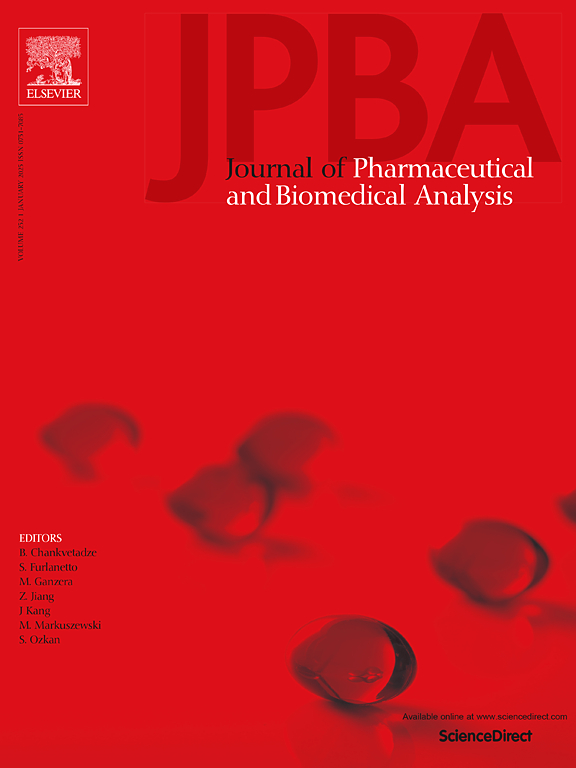In vitro metabolism and metabolite identification of eutylone using rat liver microsomes
IF 3.1
3区 医学
Q2 CHEMISTRY, ANALYTICAL
Journal of pharmaceutical and biomedical analysis
Pub Date : 2025-03-17
DOI:10.1016/j.jpba.2025.116827
引用次数: 0
Abstract
The determination of toxicokinetic parameters allows the characterization of the toxicological profile of a wide range of substances. Several models have been employed to in vitro kinetic evaluations, in which liver microsomes stands out due to its simple handling and obtaining. Eutylone is a New Psychoactive Substance (NPS) classified as a synthetic cathinone with stimulant effects on central nervous system. This substance was initially synthesized for pharmaceutical applications but ultimately became subject to recreational use, with constant seizures worldwide. Herein, the in vitro metabolism and the production of eutylone phase I and phase II metabolites was investigated using rat liver microsomes (RLM). Eutylone presented a low metabolic stability showing an in vitro elimination half-life (t1/2) of 2.27 min. The unbound fractions of eutylone in microsomal (fu-mic) and plasma (fu-p) proteins were 0.93 and 0.15, respectively. A sigmoidal profile defined by Hill equation were observed, allowing kinetic parameters calculations. The Hill coefficient (H) was 1.21, in vitro maximum velocity (Vmax) was 19.40 μmol/mg/min, substrate concentration at half Vmax (S50) was 4.78 μM, intrinsic maximum clearance (CLmax, in vitro) was 3.36 mL/min/mg, in vivo intrinsic clear-ance (CLint, in vivo) was 8.20 mL/min/kg, hepatic clearance (CLH) was 1.29 mL/min/kg, and hepatic extraction rate (EH) was 0.02. Eight eutylone metabolites were identified, four produced by phase I reactions and four by phase I followed by phase II reactions. Demethylenation and O-glucuronidation were pivotal in eutylone’s metabolism. These findings provide valuable information about the metabolism of eutylone, allowing practical implications for evaluating its safety and toxicity.
利用大鼠肝脏微粒体对丁酮进行体外代谢和代谢物鉴定
本文章由计算机程序翻译,如有差异,请以英文原文为准。
求助全文
约1分钟内获得全文
求助全文
来源期刊
CiteScore
6.70
自引率
5.90%
发文量
588
审稿时长
37 days
期刊介绍:
This journal is an international medium directed towards the needs of academic, clinical, government and industrial analysis by publishing original research reports and critical reviews on pharmaceutical and biomedical analysis. It covers the interdisciplinary aspects of analysis in the pharmaceutical, biomedical and clinical sciences, including developments in analytical methodology, instrumentation, computation and interpretation. Submissions on novel applications focusing on drug purity and stability studies, pharmacokinetics, therapeutic monitoring, metabolic profiling; drug-related aspects of analytical biochemistry and forensic toxicology; quality assurance in the pharmaceutical industry are also welcome.
Studies from areas of well established and poorly selective methods, such as UV-VIS spectrophotometry (including derivative and multi-wavelength measurements), basic electroanalytical (potentiometric, polarographic and voltammetric) methods, fluorimetry, flow-injection analysis, etc. are accepted for publication in exceptional cases only, if a unique and substantial advantage over presently known systems is demonstrated. The same applies to the assay of simple drug formulations by any kind of methods and the determination of drugs in biological samples based merely on spiked samples. Drug purity/stability studies should contain information on the structure elucidation of the impurities/degradants.

 求助内容:
求助内容: 应助结果提醒方式:
应助结果提醒方式:


